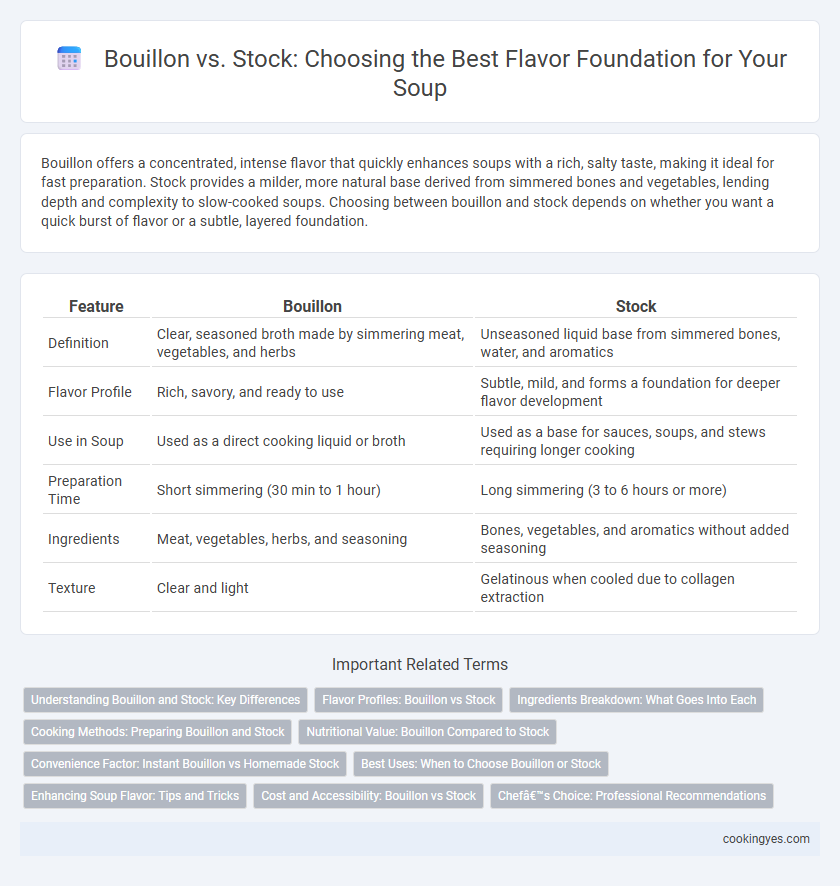Bouillon offers a concentrated, intense flavor that quickly enhances soups with a rich, salty taste, making it ideal for fast preparation. Stock provides a milder, more natural base derived from simmered bones and vegetables, lending depth and complexity to slow-cooked soups. Choosing between bouillon and stock depends on whether you want a quick burst of flavor or a subtle, layered foundation.
Table of Comparison
| Feature | Bouillon | Stock |
|---|---|---|
| Definition | Clear, seasoned broth made by simmering meat, vegetables, and herbs | Unseasoned liquid base from simmered bones, water, and aromatics |
| Flavor Profile | Rich, savory, and ready to use | Subtle, mild, and forms a foundation for deeper flavor development |
| Use in Soup | Used as a direct cooking liquid or broth | Used as a base for sauces, soups, and stews requiring longer cooking |
| Preparation Time | Short simmering (30 min to 1 hour) | Long simmering (3 to 6 hours or more) |
| Ingredients | Meat, vegetables, herbs, and seasoning | Bones, vegetables, and aromatics without added seasoning |
| Texture | Clear and light | Gelatinous when cooled due to collagen extraction |
Understanding Bouillon and Stock: Key Differences
Bouillon and stock serve as foundational liquids in soups, yet they differ significantly in preparation and flavor intensity. Bouillon is a concentrated, seasoned broth made from simmered meat, vegetables, and aromatics, typically available in cube or powder form for quick use. Stock derives its rich flavor from simmering bones, vegetables, and herbs over several hours, resulting in a gelatinous texture that adds depth and body to soups.
Flavor Profiles: Bouillon vs Stock
Bouillon delivers a more concentrated and intense flavor due to its reduced and seasoned nature, making it ideal for quick flavor boosts in soups. Stock provides a richer, deeper flavor foundation with a subtle, natural taste extracted from simmered bones and aromatics over a longer period. Culinary experts often prefer stock for complex dishes requiring layered flavors, while bouillon suits recipes needing a fast, savory impact.
Ingredients Breakdown: What Goes Into Each
Bouillon typically consists of dehydrated vegetables, meat extracts, herbs, and salt, designed to dissolve quickly for a concentrated flavor base. Stock is made by simmering bones, connective tissues, and aromatic vegetables for hours, extracting gelatin, minerals, and deeper savory essences. The distinct ingredient profiles influence the mouthfeel and depth, with stock offering a richer, fuller body while bouillon provides an instant, intense seasoning.
Cooking Methods: Preparing Bouillon and Stock
Bouillon is made by simmering meat, vegetables, and seasonings briefly to create a clear, intensely flavored broth ideal for quick soups and sauces, while stock requires hours of simmering bones, mirepoix, and aromatics to extract gelatin and develop a richer, more robust base essential for hearty dishes. The cooking method for bouillon emphasizes speed and clarity, usually involving rapid boiling and straining to maintain a clean taste and appearance. Stock preparation involves a long, gentle simmer, often 4-6 hours or more, to break down collagen from bones, yielding a silky texture and deep umami that enhances complex recipes.
Nutritional Value: Bouillon Compared to Stock
Bouillon typically contains higher sodium levels due to added salt and seasoning, whereas stock offers a more natural mineral content derived from simmering bones and vegetables. Stock provides essential nutrients such as collagen, amino acids, and minerals like calcium and magnesium, supporting joint and bone health. Choosing stock over bouillon can enhance the nutritional value of soups with fewer artificial additives and lower sodium.
Convenience Factor: Instant Bouillon vs Homemade Stock
Instant bouillon offers a highly convenient flavor base with its quick dissolution and long shelf life, making it ideal for time-sensitive cooking scenarios. Homemade stock provides a richer, more complex taste profile with natural gelatin and nutrients extracted from simmered bones, though it requires several hours of preparation and attention. Choosing between instant bouillon and homemade stock depends on the desired balance between convenience and flavor depth in soup making.
Best Uses: When to Choose Bouillon or Stock
Bouillon, typically made from dehydrated meat and vegetables, is best suited for quick, flavorful bases in soups or sauces when time is limited. Stock, simmered long with bones and aromatics, provides a rich, gelatinous foundation ideal for slow-cooked dishes and complex broths. Use bouillon for convenience and immediate flavor, while stock is preferred for depth and layered taste in gourmet recipes.
Enhancing Soup Flavor: Tips and Tricks
Bouillon offers a concentrated, intense flavor perfect for quick soup bases, while stock provides a richer, more complex taste due to its slow-simmered bones and vegetables. Enhancing soup flavor involves balancing these foundations with fresh herbs, spices, and a splash of acid like lemon or vinegar to brighten the taste. Using homemade broth or reducing commercial stock can deepen umami, creating a well-rounded, savory soup flavor profile.
Cost and Accessibility: Bouillon vs Stock
Bouillon offers a more cost-effective and accessible option for building soup flavor, often available in concentrated cubes or powders that have a long shelf life and easy storage. Stock, typically made from simmering bones, vegetables, and herbs for several hours, requires more time and fresh ingredients, increasing its preparation cost and limiting accessibility for quick meals. While stock provides a richer, more complex flavor profile, bouillon remains a practical choice for budget-conscious cooks seeking convenience without sacrificing basic taste.
Chef’s Choice: Professional Recommendations
Chefs favor bouillon for its concentrated, intense flavor that enhances soups quickly, making it ideal for fast-paced kitchen environments. Stock offers a richer, more complex base due to its slow-simmered bones and aromatics, preferred for classic, deeply layered soups. Professional recommendations emphasize selecting bouillon for convenience and stock for authenticity and depth in gourmet recipes.
Bouillon vs Stock for flavor foundation Infographic

 cookingyes.com
cookingyes.com